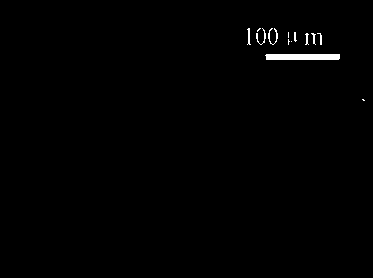Antimony-containing modifier for zinc-copper alloy and modification treatment method
A metamorphic treatment, copper alloy technology, applied in the field of alloy materials, to achieve the effect of convenient operation, increased number, and uniform distribution
- Summary
- Abstract
- Description
- Claims
- Application Information
AI Technical Summary
Problems solved by technology
Method used
Image
Examples
Embodiment 1
[0027] The modification treatment method of Zn-8Cu alloy (the mass percentage composition of Cu in this alloy is 8%), concrete steps are as follows:
[0028] (1) Melt the Zn-8Cu alloy to 640°C to obtain an alloy melt.
[0029] (2) Add a certain proportion of pure antimony to the above melt, so that the mass percentage of antimony element in the alloy is 0.08%, and then stir the melt.
[0030] (3) After 15 minutes, stir the melt again to make the antimony element evenly distributed in the melt. Then it is poured into the mold, and the modified zinc-copper alloy is obtained after cooling.
[0031] Before the modification of Zn-8Cu alloy, the ε phase branched well, and the size reached more than 200 μm ( figure 1 ), the branching of ε-phase grains is very little after metamorphosis by the method of this example, and the developed dendrites before metamorphosis are transformed into petal crystals and polyhedron / spherical grains after metamorphosis, with a size of about 90 μm ( ...
Embodiment 2
[0033] The modification treatment method of Zn-8Cu alloy (the mass percentage composition of Cu in this alloy is 8%), concrete steps are as follows:
[0034] (1) Melt the Zn-8Cu alloy to 670°C to obtain an alloy melt.
[0035] (2) Add a certain proportion of pure antimony to the above melt, so that the mass percentage of antimony element in the alloy is 0.5%, and then stir the melt.
[0036] (3) After 20 minutes, stir the melt again to make the antimony element evenly distributed in the melt. Then it is poured into the mold, and the modified zinc-copper alloy is obtained after cooling.
[0037] Before the modification of the Zn-8Cu alloy, the ε phase branches are well developed, and the size reaches more than 200 μm. After the modification by the method of this example, the branching of the ε phase grains is obviously inhibited, and the developed dendrites before the modification are transformed into petal crystals and polyhedrons after modification. Spherical grains with a ...
Embodiment 3
[0039] The modification treatment method of Zn-8Cu alloy (the mass percentage composition of Cu in this alloy is 8%), concrete steps are as follows:
[0040] (1) Melt the Zn-8Cu alloy to 690°C to obtain an alloy melt.
[0041] (2) Add a certain proportion of pure antimony to the above melt, so that the mass percentage of antimony element in the alloy is 1%, and then fully stir the melt.
[0042] (3) After 5 minutes, stir the melt again to make the antimony element evenly distributed in the melt. Then it is poured into the mold, and the modified zinc-copper alloy is obtained after cooling.
[0043] Before the Zn-8Cu alloy is modified, the ε phase branch is developed, and the size reaches more than 200 μm. After the method of this example is modified, the ε phase grain branch is significantly reduced, and the developed dendrite before the modification is transformed into the petal crystal, polyhedron / spherical shape after the modification. Grains, the size is obviously reduced...
PUM
 Login to View More
Login to View More Abstract
Description
Claims
Application Information
 Login to View More
Login to View More - R&D
- Intellectual Property
- Life Sciences
- Materials
- Tech Scout
- Unparalleled Data Quality
- Higher Quality Content
- 60% Fewer Hallucinations
Browse by: Latest US Patents, China's latest patents, Technical Efficacy Thesaurus, Application Domain, Technology Topic, Popular Technical Reports.
© 2025 PatSnap. All rights reserved.Legal|Privacy policy|Modern Slavery Act Transparency Statement|Sitemap|About US| Contact US: help@patsnap.com



